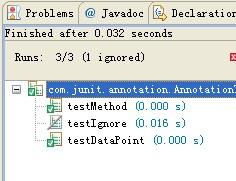JUnit Annotation
来源:互联网 发布:语音阅读文字软件 编辑:程序博客网 时间:2024/05/20 01:12
前段时间,junit annotation让我无言了一回,白疼了他两年,郁闷
junit 现在已经开发到了4.8.1版本,在这个版本中,共有19个annotation。最常用到的也有十来个。下面是无言之后写的一个junit 程序。没做什么功能,细心看,或是自己写一遍,或许那天,你就会用得上。
package com.junit.annotation;
import org.junit.After;
import org.junit.AfterClass;
import org.junit.Assert;
import org.junit.Before;
import org.junit.BeforeClass;
import org.junit.Ignore;
import org.junit.Rule;
import org.junit.Test;
import org.junit.experimental.theories.DataPoint;
import org.junit.experimental.theories.Theories;
import org.junit.experimental.theories.Theory;
import org.junit.rules.TestName;
import org.junit.runner.RunWith;
import static org.hamcrest.CoreMatchers.is;
import static org.junit.Assume.assumeThat;;
@RunWith(Theories.class)
public class AnnotationTest {
@Rule
public TestName testname = new TestName();
@DataPoint
public static String dPoint = "I love JUnit!";
//测试@BeforeClass批注,在整个测试类中只运行一次,有别于@Before。
//test the @BeforeClass annotation
@BeforeClass
public static void testBeforeClass() {
System.out.println("BeforeClass");
}
//测试@Before批注,在每个测试方法运行前执行该方法。
//test the @Before annotation
@Before
public void testBefore() {
System.out.println("Before");
}
//测试@Test批注。
//test the @Test annotation
@Test
public void testMethod() {
Assert.assertEquals("testMethod",testname.getMethodName());
System.out.println("testMethod");
}
//测试@Theory批注。
//test the @Theory annotation
@Theory
public void testDataPoint(String interests) {
//interests必须是I lvoe JUnit!,否则跳过该测试函数。
//interests must be I lvoe JUnit!, or skip the test function.
assumeThat(interests, is("I love JUnit!"));
Assert.assertEquals("testDataPoint",testname.getMethodName());
System.out.println("testDataPoint"+"/n"+dPoint);
}
//测试@Ignore批注
//test the @Ignore annotation
@Ignore
@Test
public void testIgnore() {
Assert.assertEquals("testIgnore",testname.getMethodName());
System.out.println("testIgnore");
}
//测试@After批注,每个test方法执行完成后运行此方法
//test the @After annotation
@After
public void testAfter() {
System.out.println("After");
}
//测试@AfterClass批注,在整个测试类中只运行一次,有别于@After
//test the @AfterClass annotation
@AfterClass
public static void testAfterClass() {
System.out.println("AfterClass");
}
}
执行完,测试通过,从下图可以知道@Ignore的作用吧

再看下控制台中输出的信息

从上图可以得知,标的@BeforeClass和@AfterClass的测试方法只执行了一次,而@Before和@After在每个标有@Test方法执行前后都会执行一次。这也是这几个annotation的区别。
而@Rule这个annotation这里只说了一种用法,还有其它七种用法。
附上项目结构图

这段时间在看一本测试驱动开发的书,是极限编程创始人Kent Beck写的,非常不错。让测试程序运行起来,之后再消除那些重复设计,最终使代码整洁可用(clean code that works)。呵呵,还没看完,没悟到什么。纯属瞎扯蛋!
http://www.ltesting.net/html/55/182755-169117.html
- JUnit Annotation
- JUnit Annotation
- junit annotation
- junit annotation
- junit @annotation
- 03Junit Junit的annotation
- 14 Annotation Junit 异常
- JUnit basic annotation
- JUnit的annotation
- JUnit中的注解(Annotation)
- JUnit中标注Annotation介绍
- JUnit Annotation——JUnit单元测试中批注@详解
- Junit的annotation(注释、注解)
- JUnit 4 常用的几个annotation 介绍
- JUnit中使用Annotation获得实例
- JUnit 4中annotation的用法
- UIAutomator2.0详解(JUnit Annotation篇)
- JUnit 4 使用 Java 5 中的注解(annotation)
- host1free 难道是骗子
- [Xml]HTML 和 XML 语言中的转义字符
- 单元测试利器 JUnit 4
- linux内核升级到2.6.32
- 20100717《一虎一席谈》方舟子vs唐骏观后感
- JUnit Annotation
- 单片机的无线化和无线网络化大趋势
- poj2181
- VS2005 Beta2 体验:建站方式[1]
- Summary of Changes in version 4.8
- 8051的单片机,装上802.15.4标准和ZigBee智慧
- 不错的网站,就是积分管理有点混乱
- Linux kernel的Makefile和Kconfig
- protected


